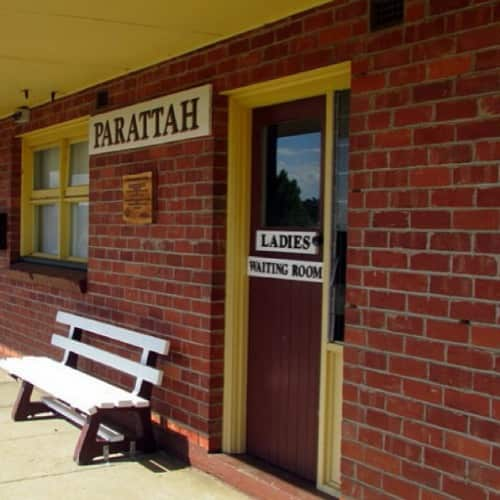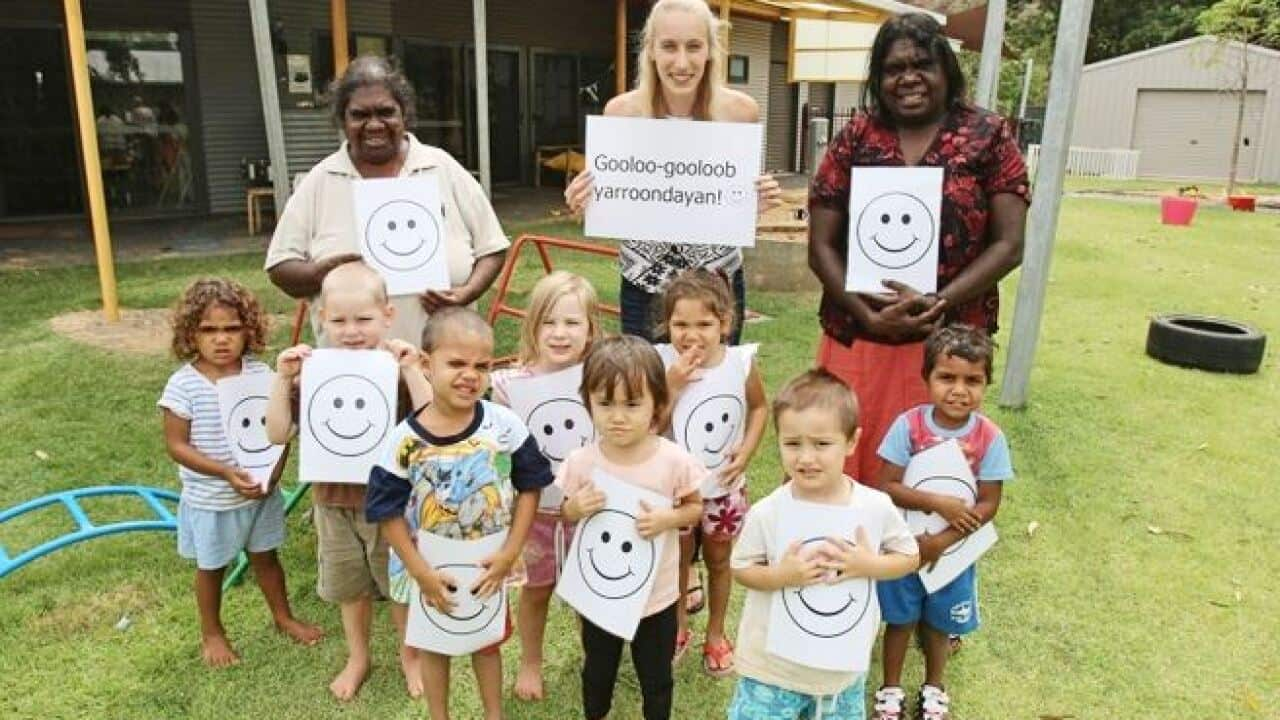Amongst the towns and cities named after European figures or reconstituted British geographical locations ( ... because the red rugged landscape of Exmouth in WA is so similar to England's seaside *cough*), many of Australia's places are taken from one of the many Indigenous languages across Australia.
The bustle of everyday life can often distract you from these cultural origins that we literally live in, like catching the train from "permanent place" (Killara) to "eel waters" (Parramatta) ; watching the eccentric Ladies from "reedy swamp" (Toorak) on that housewives program or driving the long journey to "the place of many crows" (Wagga Wagga) to Grandma's for Christmas.

Murwillumbah derives from the Bandjalang word meaning 'camping place'
Why all the Aboriginal words?
When it comes to Aboriginal words on an Australian map, we need to address the white European settlement in the room.
While Europeans who invaded Aboriginal lands often renamed the plains as par tor the process of taking possession, we still see many towns and cities with Indigenous names - why? Why would Europeans include the native language of a culture they were trying to assimilate?
When it comes to Aboriginal words on an Australian map, we need to address the white European settlement in the room.
Dr Lawrence Bamblett, Vice Chancellor Scholar in Indigenous History at ANU says that keeping Aboriginal place names is still expression of colonial power.
"Taking away land and way of life, while keeping place names - that are often anglicised anyway - recognises colonial power more than it shows respect to Aboriginal people," he told NITV.
"They [Europeans] westernised towns, rivers and places as it suited them. They had power that they used to take land by force. Keeping some place names doesn't come anywhere near balancing an invasion."
Whether the etymology of such towns were named in coercion rather than good faith or - like we - is a positive gesture made off the back of the ugliness of theft, the Indigenous words on our map speaks to an important part of our history - communication between Indigenous people and European settlers.
By analysing the names of our towns, suburbs and cities, which were christened by European settlers yet came from Aboriginal owners, we can reflect on specific past events.
'Manly' came from a tribe of men with "manly" characteristics, who Gov. Arthur Phillip interacted with in that area - so much so, he honoured them and their character and today's generation swims at 'Manly Cove'.
For example, Luke Pearson, Senior Editorial Adviser of NITV and Founder of , that the name 'Manly' came from a tribe of men with "manly" characteristics, who Governor Arthur Phillip interacted with in that area - so much so, he honored them and their character and today's generation swims at 'Manly Cove'.
Here are some of our major towns which were named by such cross-cultural communication.

Gundagai, NSW
Is said to mean, 'to cut with a hand-axe behind the knee' in Wiradjuri language. Situated on the bend of Murrumbidgee River, much like the bend in a knee, is the town Gundagai.
Narooma, NSW
A local Yuin word for 'clear blue waters'.
Wollongong, NSW
Thought to mean 'sound of the sea' in the Dharawal language.
The word is pronounced Woll-long-gong, with the second syllable being accented, and is supposedly onomatopoeic for the pounding and surging of the waves.
Dubbo, NSW
Is thought to come from a Wiradjuri word, Thubbo, which is in conjecture of two possible meanings; either 'red earth' or 'head covering', as the first permanent European settler, Robert Dulhunty's house may have looked like the shape of a hat to the local people.
Moruya, NSW
Situated on the Moruya River, the Brinja Yuin word means 'home of the black swan'.
Today, the black swan is used as a local emblem.
Katoomba, NSW
Comes from a Gundungurra word meaning 'falling water tumbling over a hill' and takes its name from a waterfall that drops into the Jamison Valley in the region.

Canberra, ACT
Thought to mean 'meeting place' in the local Ngunnawal language.
Tuggeranong, ACT
A Ngunnawal expression meaning 'cold place'.
Gungahlin, ACT
Two potential meanings of this Canberran region, both steaming from the Ngnunnawal language.
First, is 'little rocky hill'.
The second, is from a white settler, William Davis who acquired land in the area in the early 1860s, building the original 'Gungahlin Homestead', derived from the word goongarline, said to mean ‘white man’s house’. Interestingly, Davis maintained a cricket ground on his property and established the Ginninderra Cricket Team which was virtually unbeaten from the 1850s to the 1870s, playing teams from Queanbeyan, Goulburn and Braidwood. Three Aboriginal men were key players on the team, Bobby Deumonga, Johnny and Jimmy Taylor.

(Image: Flickr)
Nagambie, VIC
A Taungurung word for 'Lagoon'.
Natimuk, VIC
A Jardwadjali word thought to mean 'Little Lake'.
Geelong, VIC
Coming from the Wathaurung word, Jillong, meaning 'tongue' which may refer to the tongue-shaped of the part of the bay where Geelong is situated.
Wangaratta, VIC
A Waywurru word for 'resting place of cormorants'. Wonga, meaning '' (bird) and -ratta meaning 'meeting place of the rivers'.
Kerang, VIC
Kerang is a Wemba Wemba story of a big tree that once feel and means 'its leaves'. This demonstrates how many places stem from a significant event in a dreaming or songline story.
Tambo Upper, VIC
Situated near the Tambo River, Tambo is the Gunnai word for '' (fish), presumably a plentiful source of food in the area.

(Image: Instagram / @nise41w)
Marrawah, TAS
Peerapper language name for 'eucalypt tree'.
Legana, TAS
As the town sits at the point where the Tamar River becomes fresh water, Legana means 'fresh water' in the local Tyerrernotepanner (Palawa) language.
Parattah, TAS
Meaning 'ice and cold' in the Tarripnyenna language from The Big River tribe.

Whyalla, SA
Comes from a Barngarla word meaning, 'place with deep water'.
Oodnadatta, SA
Piccadilly, SA
Sometimes a place name that looks very English is a camouflaged, hidden Aboriginal name. The original name was in the Kaurna language, pikurdla, which literally meant ‘two eyebrows’, from piku ‘eyebrow’ and the dual suffix -rdla.
Uraidla, SA
The very same Kaurna language suffix appears in this other Adelaide Hills place name, meaning ‘two ears’; from yuri ‘ear’ and the dual suffix -rdla.

(Image: Flickr) Source: Kalgoorlie Boulder
Mandurah, WA
A Noongar word originally as mandjar meaning, 'meeting place'.
Balingup, WA
The name was first recorded by a surveyor in 1850, and is said to be derived from the name of a local Aboriginal warrior, Balingan.
Tammin, WA
Takes it name from the nearby Tammin Rock, which is thought to come from a Noongar word Tammar, a name for the 'Black Gloved Wallaby'.
Kalgoorlie, WA
Steams from the Wangai word Karlkurla or Kulgooluh, meaning 'place of the silky pears' referring to local edible fruit.
Kununurra, WA
A (failed) English translation of the Miriwoong word Goonoonoorrang which means ‘river’, as the town is situated near the Kununurra River.
Yallingup, WA
Meaning, 'a large hole in the ground', the town takes its name from a nearby cave (Yallingup Caves) or originally, "Ngilgi's Cave". Ngilgi's Cave comes from an Aboriginal legend where a vicious fight occurred between a bad spirit who lived in the cave and a good spirit (Ngilgi) who lived in the "Wardan" (the ocean). Yal means large hole in Wardandi (People of the ocean) language.
Yalyalup, WA
A Wardandi variation of 'place of many holes'.

Berrimah, NT
Leading up to the bombing of Darwin and in the early 1940s, action was being taken to erect the Army General Hospital at the camp site to be known as "Berrimah", the Army using the origin of the local Larrakeyah word 'to the south'.
Mataranka, NT
Thought to mean 'home of the snake' in the local Yangman language.
Kakadu, NT
Steams from Gagudju, the language spoken by the people who lived north of the Park. This language is no longer spoken in the region.
Larrimah, NT
Meaning 'resting place' in the local Yangman language.

(Image: Flickr)
Noosa, QLD
A Kabi Kabi word meaning 'shady place'.
Toowoomba, QLD
The local Aboriginal people's pronunciation of the English word 'swamp'.
"Sometimes a place name that looks Aboriginal is actually the Aboriginal pronunciation of an English word," says Professor Ghil‘ad Zuckermann, Chair of Linguistics and Endangered Languages at the University of Adelaide. "Aboriginal languages usually do not have the 'S' sound. Neither do they distinguish between voiced sounds like B-G-D; and voiceless sounds like P-K-T."
Badu Island, QLD
The Traditional Owners of the Torres Strait island are known as the Badulgal and Mualgal people, which was shortened to 'Badu' and the island was named to honor local people.
Bundaberg, QLD
A multilingual name; the city name is thought to be a combination of bunda, the Kabi Kabi word for an 'important man', and the suffix -berg meaning 'town' from the Old English beorg (a hill).
Professor Ghil‘ad Zuckermann, Chair of Linguistics and Endangered Languages at the University of Adelaide believes in "Native Tongue Title" and told NITV,
"I urge Australia to define the 330 Aboriginal languages, most of them sleeping beauties, as the official languages of their region. [Australia should] introduce bilingual signs and thus to change the linguistic landscape, of this beautiful country. So, for example, Port Lincoln should also be referred to as Galinyala, which is its original Barngarla name."
For all the latest Indigenous news, features and video content at NITV like us on and




